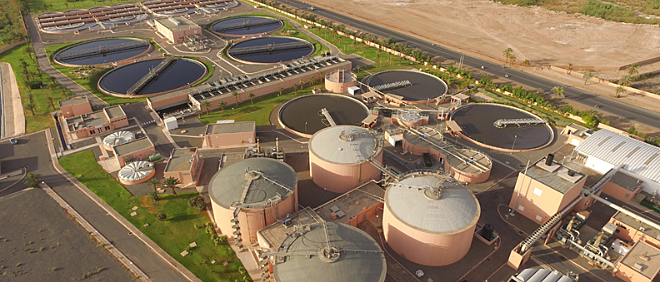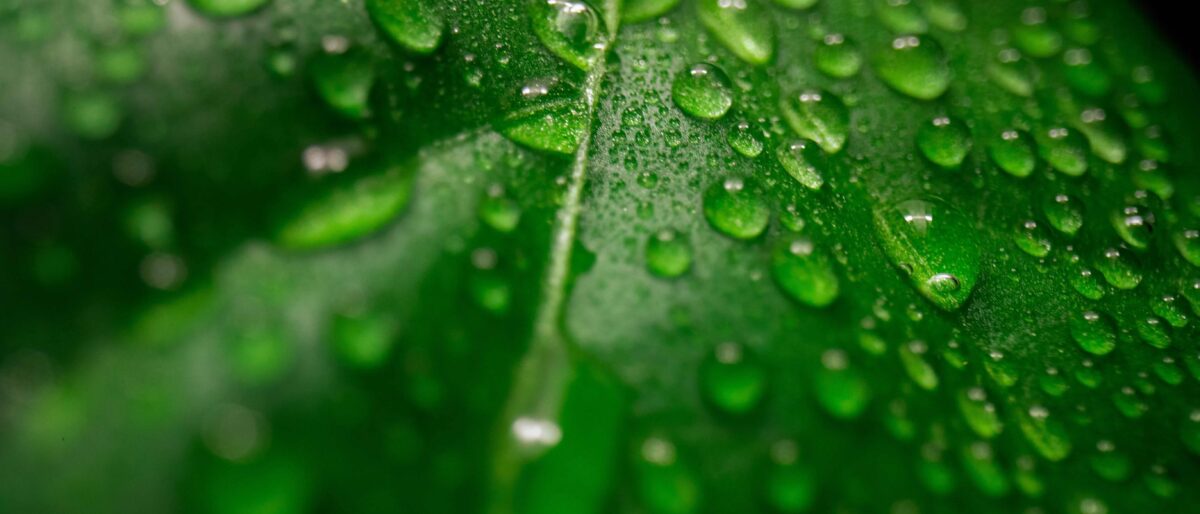Marrakech municipal wastewater treatment
The first treatment facility in the region integrating biogas production, water reuse and solar sludge drying.
LUCAS® CAROUSEL wastewater treatment
BIOTIM® Sludge digestion
HYDROGONE® greenhouse sludge drying
Operation and Maintenance
Marrakech, Marocco
2011
Treated wastewater: 237.000 m³/d
Biogas production: 22.500 Nm³/d
Energy production: 1,6 MWe
CO2 reduction: 60.000 tons/y
Air treatment: 80.000 Nm³/h
Solar sludge drying: saving 5MWe/d

Biological wastewater treatment
Until 2008, the sewage of Marrakech-tensift El Haouz was disposed in the river Tensift after minimal treatment, jeopardizing sanitary conditions for its population. Today, the Marrakech municipal wastewater treatment plant is Africa's most sustainable wastewater treatment plant.
The biological sewage treatment process includes a primary treatment, a secondary or biological treatment and a tertiary treatment, making the water ready for reuse. Sludge is digested and turned into biogas. The digested sludge is dehydrated in greenhouses, using solar thermal power.

Pre-treatment of incoming sewage
The purpose is to prevent the incoming sewage from damaging the equipment.
- Screening: coarse and fine screens keep debris out
- Grit removal: removing sedimentary wastes like sand, silt and grit
- Grease removal: removal of oils and greases disturbing the treatment process
Primary settling
After pre-treatment, the water flows to the primary sedimentation tanks or primary settlers. The suspended solids settle by gravitation and are collected by a rotating scraper into a hopper in the base of the tank. The clear water is decanted and ready for the secondary or biological treatment. The suspended solids or sludge are collected and thickened.

Secondary Treatment
During secondary or biological treatment, the biological pollution is degraded by micro-organisms in aerated reactor tanks. The waterborne micro-organisms eliminating biodegradable soluble organic contaminants are referred to as activated sludge.
After secondary treatment, part of the purified water is separated from the activated sludge in 4 clarifiers, and sent back into the Wadi Tensift. As with the primary sludge, the secondary sludge is collected at the bottom of the clarifiers and then thickened.

Tertiary treatment
To prepare the treated water for reuse in agriculture or for irrigation of the golf courses, a tertiary treatment step is required. Each year, up to 30 million m³ of water can be reused. The tertiary treatment includes:
- Coagulation: adding ferric chloride for destabilizing colloidal suspensions
- Flocculation: adding polymers for the suspended solids to form larger floc
- Sand filtration: eliminating the floc of suspended solids
- Treating bacterial contamination: ultraviolet disinfection (UV) and chlorination
The Marrakech wastewater treatment plant is the largest and most sustainable on the African continent

Sludge digestion and green energy production
Sludge coming from the secondary treatment is mixed with the sludge from the primary treatment in a closed digester. This reactor creates an anaerobic environment, favouring the degradation of the organic matter from the sludge and thus creating biogas.
The biogas is stored into methane tanks and fuels a cogeneration unit consisting of 4 engines, producing green electricity and heat, providing up to 50 percent of the plant’s energy needs.
Air treatment
To control foul odors, 80.000 Nm³ of air/h is treated. Volatile Organic Compounds (VOC) and odors are treated using biofilters and bioscrubbers, an environmentally neutral process, requiring neither chemical treatment nor additional energy.

Solar sludge drying
Digested sludge represents large volumes of wet dry matter content. To cut sludge handling and transportation costs, the digested sludge is dehydrated in large greenhouses. Robots continuously stir the sludge while the sun heats the greenhouses, increasing dry matter content from 22% up to 80%.
The HYDROGONE® Greenhouse solar sludge drying is the most sustainable sludge dewatering solution in regions where sunlight and -heat are abundant.
More about our LUCAS® aerobic wastewater treatment
Are you looking for an advanced aerobic wastewater treatment solution? Our aerobic LUCAS® technology may be the answer you've been searching for.
Other cases

Protecting the environment in Fez
The Fez municipal wastewater treatment plant returns safe discharge water into the river bed.

Compact drinking water plant in Khemmiset
Doubling capacity to meet the demands of a growing population.

A capex-free upgrade for Martens Brewery
A new treatment strategy materialized in an out-of-the-box approach and a long-term partnership.
Find your local contact
Our expertise is always within reach. Digital communication has cut long distances short, but we advocate the traditional way of sharing insights.
Contact us today. We are looking forward to help you reach your sustainable development goals.




